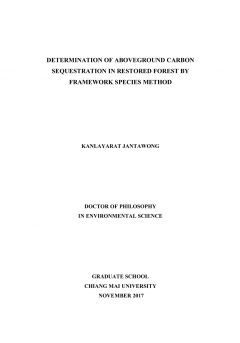The Nan Project, directed by Assist. Prof. Dr. Dia Shannon comprises 3 research initiatives:
-
From a Bare Mountain to a Regenerated Forest: compared landscape planting designs for forest restoration in Nan Province, sponsored by the National Science and Technology Development Agency (NSTDA), 2017 to 2020.
-
Forest Landscape Restoration and Community Well-being: supported by the Program Management Unit on Area Based Development (PMU A), 2020 to 2021.
-
Evaluating Changes and Ecosystem Services of Nan Restored Forests: funded by the National Science and Technology Development Agency (NSTDA), 2021 to 2022.
The research spans three districts of Nan Province—Pua, Phu Phiang and Wiang Sa—with three plots in each district. The project commenced with a survey of reference forest remnants, near the restoration sites, including i) the Nam Kaen - Nam Sa Watershed Forests (Phu Phiang District), supervised by the Royal Forest Department; ii) Mon Hin Kaew Community Forest (Pua District) and iii) Ban Muang Noeng Community Forest (Wiang Sa District). The survey involved documenting tree density, species diversity and phenology, as well as bird diversity, over three years. Such data were then compared with the same in restoration forests, established in the 3 districts.
Knowledge of the framework species method of forest ecosystem restoration was transferred to local communities and restoration plots of various sizes were planted with a range of indigenous framework tree species. Post-restoration activities include frequent weeding and fertilizer application, as well as the cutting of firebreaks in the dry season. Monitoring focused on survival and growth rates of each species, as well as the diversity of soil microbial communities. Ecosystem services, provided by the restored forests, including climate control, were evaluated, along with forest products used by local people. The effects of restoration on the quality of life of local people was also assessed. Currently, villagers who are project members continue to actively contribute to the care of the restored forest, to ensure its long-term health and growth.
In collaboration with:
Biodiversity
Biodiversity recovery is one of the main aims of forest restoration - but what to measure? Plants? Birds? Mammal? Learn simple monitoring techniques here.
31: Factors Affecting the Recruitment of Tree Species in Restored Tropical Forest, Chiang Mai Province, Thailand
Abstract: FORRU-CMU has been developing and adapting the framework species method of forest restoration (FWS) to restore tropical forest ecosystems to degraded forest land in northern Thailand,...
32: Tree species composition and height-diameter allometry of three forest types in northern Thailand
ABSTRACT: Understanding the tree species composition of tropical forests provides information for forest restoration and conservation. The objectives of this study were to determine the tree...
33: Seed and microsite limitations of large-seeded, zoochorous trees in tropical forest restoration plantations in northern Thailand
ABSTRACT: On deforested or degraded land, planting mixtures of native forest tree species facilitates establishment of incoming tree seedling species (i.e. "species recruitment") by rapidly...
34: Where science meets communities: developing forest restoration approaches for northern Thailand
ABSTRACT: This paper contrasts lessons learned from two forest restoration research projects in Doi Suthep-Pui National Park, near Chiang Mai City, northern Thailand, which combined science with...
35: Determination of aboveground carbon sequestration in restored forest by framework species method
ABSTRACT: Tropical deforestation reduces the global terrestrial carbon sink and substantially contributes towards global climate change. Conversely, tropical forest restoration could help to...
36: Principles of restoring tropical forest ecosystems and opportunities for conserving endemic, endangered and threatened tree species
ABSTRACT Restoring tropical forest ecosystems involves manipulating natural regeneration to achieve the maximum biomass, structure, biodiversity and ecological functioning that are possible within...
37: Potential seed predators in an abandoned agricultural area in northern Thailand
ABSTRACT: One limitation of forest restoration by direct seeding in degraded areas is seed predation by animals foraging on the ground. Seeds sown on the ground can be removed or destroyed leading...
38: Second Growth : The Promise of Tropical Rain Forest Regeneration in the Age of Deforestation—Review
Robin Chazdon In Second Growth, Robin Chazdon conveys the message that tropical forests are “malleable” and should be helped to achieve their maximum potential for regeneration wherever...
39: Forest restoration at the landscape level in Thailand
Thailand is located in the Centre of the Indochina Peninsula, with a total land area of 513,115 sq km. Due to variations in climate and physiographical characteristics, various types of forests...
40: When does seed limitation matter for scaling up reforestation from patches to landscapes?
There's a neat little app that goes with this paper. Check it out - https://t-trevorcaughlin.shinyapps.io/ReforestationDynamics ABSTRACT: Restoring forest to hundreds of millions of hectares...











